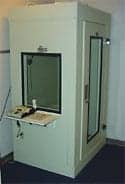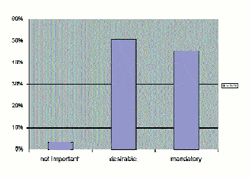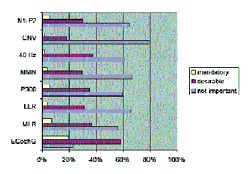How concerned should we be about MP3 and other personal music players? What should we define as “too much or too loud?”
At the writing of this article, just over a year has passed since the publication of “Output Levels of Commercially Available Portable Compact Disc Players and the Potential Risk to Hearing” by Fligor and Cox in Ear and Hearing.1 The timing of this publication was fortuitous, as this topic has since been deemed “sexy” by the popular media, and a considerable amount of press coverage has been given to the current discussion.
Since August 2005, many within our profession, including this author, have given radio, television, and print interviews about whether or not the use of headphones is inherently “dangerous.” It is this author’s opinion that all this press coverage is, on the whole, good for the profession and the patients we serve—if for no other reason than to promote the concept of hearing conservation and that the word “audiologist” has been used with greater frequency than any other time in this young audiologist’s career.
This is not, however, a new controversy, as was pointed out by Robert (Bob) Sanderson, MA, owner of Boston Hearing Services, who was co-author of the 1982 Katz et al2 study “Stereo Earphones and Hearing Loss” published in the New England Journal of Medicine. According to Sanderson, when that study was published over 20 years ago, news outlets were hot for the topic at that time as well. The current sensitivity of the topic has, this author believes, been heightened by the timing of the popularity of the Apple iPod MP3 player. According to Internet reports from Canalys,3 a market research company, 25.6 million iPod players were sold in the first half of 2005.
With all due respect to the professionalism of many journalists who have given “hearing” and “hearing loss prevention” a voice in the public conscience, the popular media has a product to sell, and often that product’s value is increased by hype and perceived controversy. Some inaccuracies have resulted, and this author hopes to clarify a few of the myths. It is important to approach this topic with as careful scientific rigor as any other research, or else we risk watering-down the message and invalidating our efforts. It is this author’s desire to approach this article with all respect deserved by those who have worked carefully to understand the mechanisms of noise-induced hearing loss (both in the occupational and recreational settings).
Understanding Issues in Protecting Ears from Overexposure to Music
In this author’s current clinical practice at Children’s Hospital Boston, the most common presenting chief complaint is not “my child listens to his headphones too loud!” Any concern for noise induced hearing loss (NIHL) in the pediatric population tends to be an afterthought (eg, a parent arrives with the toddler with chronic ear infections and an older sibling is in-tow with his personal stereo system blaring). When it is observed in the patient, often it is by accident, as in a young man referred for audiological evaluation as part of medical work-up for a cholesteatoma. The right-sided cholesteatoma resulted in a moderate conductive hearing loss in the right ear, but the audiogram demonstrated a moderate “notch” in the left ear (Figure 1). There is no explanation for this young man’s left-sided sensorineural hearing loss other than daily use of his headphones at a high level.

FIGURE 1. A 12-year-old boy with longstanding right-sided conductive hearing loss, uses personal stereo system daily, but at higher level "when my [right] ear is acting up." Note the moderate notch in the left ear. Tympanograms: Normal in left; flat trace in right.
The motivation for the Fligor and Cox1 article was one such “accident.” A 15-year-old boy came to the clinic at Boston Medical Center (where I was doing my student clinical placement) complaining of difficulty hearing in his right ear. Otoscopy showed an earwax impaction in that ear. After having the earwax cleaned out, his hearing was tested. The results showed that hearing in the ear that was plugged with wax was normal, but in the other “good ear” that wasn’t plugged with wax, his hearing test results were suggestive of noise-induced hearing loss (Figure 2). When asked what noise he was exposed to, the only possible source was the CD player he pulled out. When asked what level he turned it up to, he said, “All the way up! That’s where it sounds best.” It seems the earwax plug was actually protecting his hearing in one ear, but now we were faced with counseling him how to safely use his headphones.

FIGURE 2. A 15-year-old boy reported difficulty hearing in the right ear. Otoscopy revealed cerumen impaction on the right ear, patent ear canal on the left. Following right-sided cerumenectomy, the above audiogram was obtained. The boy uses personal stereo system daily “all the way up, because that’s where it sounds the best” per patient report. Audiogram suggests that the cerumen impaction in right ear may possibly have protected his hearing.
To date, hearing care professionals have not had useful guidelines for telling people what listening levels are OK and what levels are not. Such guidelines would help counsel the patient on how to keep from regularly exceeding maximum safe exposures. True, it’s likely that a good number of people appropriately self-regulate their listening, and so are not at risk, but the literature suggests that between 5% to 25% do not.4-8
Anecdotally, it seems there is potential for headphones to cause hearing loss. Published studies have fallen on both sides of the fence, but the sum of the literature suggests that a person could choose to listen chronically at high enough levels and long enough durations to cause a permanent threshold shift (or other auditory injury). But what is the cut-off level? How loud is too loud on the volume control of the personal stereo system?
Those in hearing conservation should cringe at that question; it’s not just how loud (that is, the level), but it’s the exposure—expressed as the Time-Weighted Average (TWA) or the analogous Noise Dose—that should be considered. Numerous studies into occupational noise exposure and regulations to protect the hearing of the noise-exposed worker tell us that a significant percentage of people who regularly exceed the maximum safe exposure (greater than a 100% noise dose) will eventually sustain noise induced hearing loss.9
As Chasin noted succinctly in his article in this issue of The Hearing Review, there are important physical differences between industrial noise and music. These physical differences may affect the actual risk for noise induced hearing loss, and thus it may be inappropriate to apply damage-risk criteria adopted by the National Institute for Occupational Safety and Health (NIOSH)10 or by the Occupational Safety and Health Administration (OSHA).11 Likewise, in the studies establishing our current damage-risk criteria, the industrial noises to which people were exposed were ambient (in the free-field), as opposed to in the near-field of the ear or ear canal.
So, Where’s the Danger Point on the Volume Control?
Acknowledging the physical differences between industrial noise and music, and accounting for the effects of the acoustics of the ear in the near-field on sound levels presented via earphones, Fligor and Cox1 provided recommendations for the “cut-off level” for using CD players. Using an acoustically-correct mannequin (KEMAR), the output levels of a variety of CD players and earphones were surveyed at different volume control settings. One purpose of the ear canal is to boost sounds between 2000 Hz and 3000 Hz by as much as 15 dB; the overall level of sounds presented via the soundfield would be a few decibels higher at the eardrum, relative to the shoulder. Given that damage-risk criteria are based on A-weighted sound levels that were recorded outside the ear canal (eg, at the shoulder), the ear canal resonance must be subtracted from the level recorded at KEMAR’s “eardrum” (the location of the microphones). This was done via manufacturer-provided data to equate to free-field equivalent levels. A-weighting was applied offline.

FIGURE 3. Mean A-weighted free-field equivalent output level for each of six CD players across headphones. Recordings were made at gain settings 5 through 10, including AVLS (Automatic Volume Limiting System) on the Sony systems (corresponding to level 3.5). Error bars represent the standard deviation across the different earphones used in the study. From Fligor and Cox (Ear and Hearing, 2004).1 Used with permission.
Shown in Figure 3 are the A-weighted free-field equivalent levels of different CD players. Large differences can be seen between the different manufacturers. For example, the Panasonic CD player output levels were on average considerably less than the Sony CD Walkman, which in turn had considerably lower output levels than the Optimus and RCA CD players. Given that headphones are available for purchase separately, output levels were measured using different types of earphones, including earphones that surround the pinnae (circum-aural), earphones that are oriented vertically in the concha (vertical), and earphones that sit in or directly on the ear canal (in-the-ear or insert). These levels were compared to the earphones that came with the CD players (“stock” earphones), which were typically the type of earphone that rest on top of the pinna (supra-aural).

FIGURE 4. Output levels of used vs new Sony portable CD players. Squares denote the output levels across gain settings for the used systems and solid diamonds indicate the output levels of new systems. Note: The apparent differences in level between new and used systems were attributed to different earphones used for output measurement. Unfilled diamonds indicate the output levels measured from the new systems using two insert style headphones at the highest gain setting. Error bars are the 95% confidence interval about the mean. From Fligor and Cox (Ear and Hearing, 2004).1 Used with permission.
An observation was made that output levels from the vertical style and insert style earphones were higher than the stock earphones. To demonstrate this finding, the average levels across models of Sony CD players were compared using stock earphones and two insert earphones. Shown in Figure 4 are the output levels across models of both new and used Sony CD players with stock earphones and new Sony CD players with insert earphones (shown at maximum volume control only for simplicity of presentation). The comparison of new and used CD players was to consider if output levels drifted as systems aged, and there was no obvious difference (the Analysis of Variance comparing seven new and seven used CD players did not yield a significant difference, controlling for type of earphone used in the measure). The comparison between the two insert earphones and the supra-aural earphones revealed a statistically significant difference; Sony in-the-ear earphones were 7 dB higher, and Koss in-the-ear earphones were 9 dB higher, than supra-aural earphones.
A conservative damage-risk criterion was used for considering whether or not the output levels of the CD players could pose a risk to hearing. The damage-risk criterion considered appropriate by NIOSH10 considers 85 dBA for 8 hours to represent a maximum exposure, and an equal exposure is achieved in half the time with every 3 dB increase in level. This 85 dBA Time-Weighted Average (TWA) is considered sufficient to protect 85%-90% of the population12 from sustaining a material hearing impairment after decades of industrial noise exposure.

According to the 85 dB TWA damage-risk criterion, a person could be exposed to 94 dBA for 60 minutes before reaching a 100% noise dose. The volume control setting that resulted in output levels of 94 dBA was roughly 70% of maximum. Considering that people are exposed to other high sound levels during the day, and several factors could cause a person to be exposed to greater than 94 dBA for 1 hour even if that is the target, Fligor and Cox1 recommended that a person should not listen for longer than 60 minutes at 60% of the maximum volume control setting.
Work has continued to consider if the blanket recommendation by Fligor and Cox1 should be applied to the use of MP3 players. This author hopes to publish, with co-author Cory Portnuff, a PhD student from the University of Colorado at Boulder, the follow-up study in the next few months considering the output levels of three different manufacturers of MP3 players used with different types of earphones.
It is premature to suggest that “stock” in-the-ear earphones provided with MP3 players are 7-9 dB higher than the output level from supra-aural earphones with CD players (as has been misinterpreted in some media reports). Provided in Table 1 are the output levels from an Apple iPod Nano™ using the stock earbud earphones across volume control settings, and the corresponding time to reach the 85 dBA TWA maximum exposure.

TABLE 1. Unpublished data of an iPod Nano, recorded on a KEMAR, with eardrum to free-field acoustical corrections and A-weighting applied offline.
Even though these levels were recorded using stock earbud earphones, these free-field equivalent levels are not appreciably different from the Sony CD Walkman using stock supra-aural earphones. Further work will confirm if these levels are consistent across different models of iPods, and if these levels are typical of MP3 players from different manufacturers.
But What Do People Really Do?
This article has focused on the physical measurements of output levels from personal stereo systems, and not on typical listening levels. The potential risk to hearing has been considered based on a conservative damage-risk criterion used to protect occupationally exposed workers. The true risk to hearing from using personal stereo systems would be extremely difficult to assess, as a dose-effect relationship would have to be established retrospectively. Unlike occupational settings, people who use personal stereo systems do not obtain annual hearing tests mandated by hearing conservation programs. Likewise, noise surveys are not conducted on personal stereo systems of the typical listener.
Considering the levels a person may choose to listen to their personal stereo systems, Williams8 documented listening levels under what was considered “worst case conditions” where the listening environment was noisy (ambient noise level was 73.2 dBA, standard deviation of 2.3 dB). The average 8-hour TWA was 79.8 dBA (standard deviation of 9.0 dB), with a small but statistically significant difference between listening levels of men (80.6 dBA) and women (75.3 dBA). Williams8 concluded that, on average, noise exposure from personal stereo system use did not constitute a risk to hearing. However, 13 of the 55 personal stereo system users in the study exceeded an 85 dBA TWA, with two users exceeding an 8-hour TWA of 100 dBA.

Work this author is currently undertaking with Dr. Terri Ives from the Pennsylvania College of Optometry School of Audiology considers if the type of earphone affects listening behavior. This study, sponsored by Etymotic Research Inc, has benefited from the technical assistance of Drs. Mead Killion and Gail Gudmundsen, and from fellow author in this issue of HR, Patty Niquette. We propose to assess the chosen listening level in quiet and in varying levels of background noise. Pilot study data (Figure 5) demonstrated that, above a threshold ambient noise level, subjects increased chosen listening level as a function of ambient noise level. Even with only four subjects, the slope of the change in chosen listening level above this threshold ambient noise was significantly associated with the amount of ambient noise attenuation provided by the earphone. The baseline listening level (in quiet) was not associated with earphone type (in-ear vs over-the-ear).
Conclusion
It is yet to be seen if we will see large numbers of people with noise induced hearing loss due to listening to music via personal stereo system headphones. To date, there have been few documented cases of significant hearing loss that can be linked to using headphones.
Have listening behaviors changed with the advent of compressed music file (MP3) players that don’t require the user to change tape cassettes or compact discs? If people are on average listening for much longer periods of time than they did using older technology, then it is possible we will start seeing hearing loss from using headphones on a more regular basis. If listening behaviors have not changed, the current perceived level of risk may well be overstated.
As “hearing loss preventionists,” it is our responsibility to consider critically the level of risk and educate our patients and the public appropriately. Popular media attention of the topic can be very useful to promote our agenda of hearing loss prevention and educate the public about who we are as a profession. Ultimately, this is a win-win situation, as long as we hold ourselves to very high professional standards (state the problem appropriately without adding to the hype) and realize that, ultimately, what is best for the patient is best for everyone.

|
Correspondence can be addressed to HR or Brian Fligor, ScD, LO-367, 300 Longwood Ave, Boston, MA 02115; email: [email protected].
References
1. Fligor BJ, Cox LC. Output levels of commercially available portable compact disc players and the potential risk to hearing. Ear Hear. 2004;25:513–527.
2. Katz AE, Gertsman HL, Sanderson RG, Buchanan R. Stereo earphones and hearing loss. New England Jour Med. 1982;307:1460-1461.
3. Canalys Web page. "Portable music player market expected to double by the end of 2005." Reading, UK: Canalys. Available at: http://www.canalys.com/pr/2005/r2005091.htm; Accessed January 6, 2006.
4. Catalano PJ, Levin SM. Noise-induced hearing loss and portable radios with headphones. Intl Jour Ped Otorhinolaryngol. 1985;9(1):59-67.
5. Clark WW. Hearing: The effects of noise. Otolaryngol-Head & Neck Surg. 1992;106(6):669-676.
6. Rice CG, Breslin M, Roper RG. Sound levels from personal cassette players. Brit Jour Audiol. 1987;21:273-278.
7. Rice CG, Rossi G, Olina M. Damage risk from personal cassette players. Brit Jour Audiol. 1987;21:279-288.
8. Williams W. Noise exposure levels from personal stereo use. Intl Jour Audiol. 2005;44:231-236.
9. Prince MM, Stayner LT, Smith RJ, Gilbert SJ. A re-examination of risk estimates from the NIOSH Occupational Noise and Hearing Survey (ONHS). J Acoust Soc Am. 1997;101(2):950-963.
10. National Institute for Occupational Safety and Health (NIOSH). Criteria for a recommended standard: Occupational noise exposure, revised criteria. Pub. No. 98-126; Cincinatti: NIOSH; 1998.
11. Occupational Safety and Health Administration. Occupational noise exposure: Hearing conservation amendment; Final rule. Federal Register. 1983;48:9738-9785.
12. Occupational Safety and Health Administration. (1981). Occupational noise exposure: Hearing conservation amendment. Federal Register. 1981;46,4078-4179.




